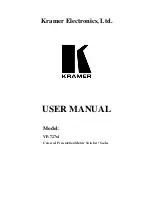
C
HAPTER
33
| Spanning Tree Commands
– 774 –
spanning-tree mst
cost
This command configures the path cost on a spanning instance in the
Multiple Spanning Tree. Use the
no
form to restore the default auto-
configuration mode.
S
YNTAX
spanning-tree mst
instance-id
cost
cost
no spanning-tree mst
instance-id
cost
instance-id
- Instance identifier of the spanning tree.
(Range: 0-4094, no leading zeroes)
cost
- Path cost for an interface. (Range: 0 for auto-configuration,
1-65535 for short path cost method
13
, 1-200,000,000 for long path
cost method)
The recommended path cost range is listed in
Table 100 on
page 769
. The recommended path cost is listed in
Table 101 on
page 769
.
D
EFAULT
S
ETTING
By default, the system automatically detects the speed and duplex mode
used on each port, and configures the path cost according to the values
shown below. Path cost “0” is used to indicate auto-configuration mode.
When the short path cost method is selected and the default path cost
recommended by the IEEE 8021w standard exceeds 65,535, the default is
set to 65,535. The default path costs are listed in
Table 102 on page 770
.
C
OMMAND
M
ODE
Interface Configuration (Ethernet, Port Channel)
C
OMMAND
U
SAGE
◆
Each spanning-tree instance is associated with a unique set of VLAN
IDs.
◆
This command is used by the multiple spanning-tree algorithm to
determine the best path between devices. Therefore, lower values
should be assigned to interfaces attached to faster media, and higher
values assigned to interfaces with slower media.
◆
Use the
no spanning-tree mst cost
command to specify auto-
configuration mode.
◆
Path cost takes precedence over interface priority.
E
XAMPLE
Console(config)#interface Ethernet 1/5
Console(config-if)#spanning-tree mst 1 cost 50
Console(config-if)#
R
ELATED
C
OMMANDS
spanning-tree mst port-priority (775)
13. Use the
spanning-tree pathcost method
command to set the path cost method.
Summary of Contents for ES3510MA
Page 1: ...Management Guide www edge core com 8 Port Layer 2 Fast Ethernet Switch...
Page 4: ...ABOUT THIS GUIDE 4...
Page 30: ...CONTENTS 30...
Page 40: ...FIGURES 40...
Page 46: ...TABLES 46...
Page 48: ...SECTION I Getting Started 48...
Page 72: ...SECTION II Web Configuration 72...
Page 88: ...CHAPTER 3 Using the Web Interface Navigating the Web Browser Interface 88...
Page 116: ...CHAPTER 4 Basic Management Tasks Resetting the System 116...
Page 154: ...CHAPTER 5 Interface Configuration VLAN Trunking 154...
Page 216: ...CHAPTER 8 Spanning Tree Algorithm Configuring Interface Settings for MSTP 216...
Page 350: ...CHAPTER 14 Security Measures DHCP Snooping 350...
Page 440: ...CHAPTER 17 IP Services Displaying the DNS Cache 440...
Page 484: ...CHAPTER 19 Using the Command Line Interface CLI Command Groups 484...
Page 554: ...CHAPTER 21 System Management Commands Switch Clustering 554...
Page 574: ...CHAPTER 22 SNMP Commands 574...
Page 582: ...CHAPTER 23 Remote Monitoring Commands 582...
Page 636: ...CHAPTER 24 Authentication Commands Management IP Filter 636...
Page 736: ...CHAPTER 29 Port Mirroring Commands RSPAN Mirroring Commands 736...
Page 816: ...CHAPTER 34 VLAN Commands Configuring Voice VLANs 816...
Page 830: ...CHAPTER 35 Class of Service Commands Priority Commands Layer 3 and 4 830...
Page 848: ...CHAPTER 36 Quality of Service Commands 848...
Page 900: ...CHAPTER 38 LLDP Commands 900...
Page 910: ...CHAPTER 39 Domain Name Service Commands 910...
Page 916: ...CHAPTER 40 DHCP Commands DHCP Client 916...
Page 948: ...CHAPTER 41 IP Interface Commands IPv6 Interface 948...
Page 950: ...SECTION IV Appendices 950...
Page 982: ...INDEX 982...
Page 983: ......
















































